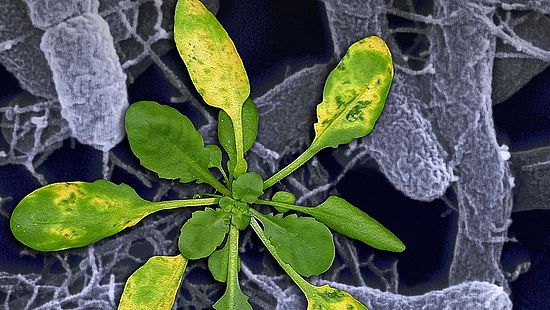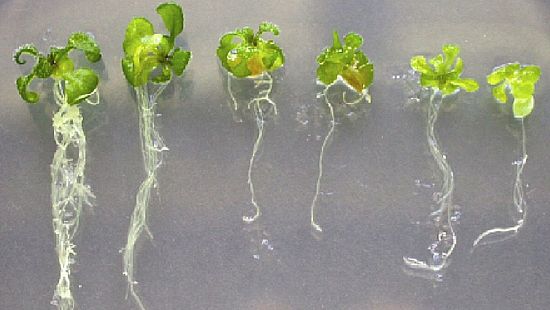Molecular aspects of symbiosis and pathogenesis in plants
Molecular Plant-Microbe Interactions
Plants interact with microbes (bacteria and fungi), in both friendly and hostile ways – this is the essence of plant symbiosis. Our studies focus on the molecular recognition events that take place in such plant-microbe encounters, and on the plants' means to distinguish between friend and foe.
Plants have an extremely acute chemical sense, “a nose”, so to speak, for molecules that are characteristic of microbes. One of our preferred examples is the plant's ability to “smell” bacterial flagellin, the main component of the flagellum, which allows bacteria to move. Flagellin triggers massive changes in gene expression in the model plant Arabidopsis, and the response is reminiscent of the “innate immunity” response, thought to be a first line of defense in animals and humans. Plants respond very differently to “friendly” microbes, such as nitrogen-fixing rhizobia and mycorrhizal fungi. Using Medicago truncatula as a model plant, we study the recognition of such symbionts and the molecular events lea- ding to a mutually beneficial symbiosis.
Recent Publications
- Rate of hyphal spread of arbuscular mycorrhizal fungi from pigeon pea to finger millet and their contribution to plant growth and nutrient uptake in experimental microcosms
Schuetz, Lukas; Saharan, Krishna; Maeder, Paul; Boller, Thomas; Mathimaran, Natarajan
Applied Soil Ecology 10.1016/j.apsoil.2021.104156 JAN 2022 - From isolation to application: a case study of arbuscular mycorrhizal fungi of the Arabian Peninsula
Al-Yahya'ei, Mohamed N.; Blaszkowski, Janusz; Al-Hashmi, Hamood; Al-Farsi, Khaled; Al-Rashdi, Ismail; et al.
Symbiosis 10.1007/s13199-021-00824-x DEC 2021 - Proteome adaptations under contrasting soil phosphate regimes of Rhizophagus irregularis engaged in a common mycorrhizal network
Recorbet, Ghislaine; Calabrese, Silvia; Balliau, Thierry; Zivy, Michel; Wipf, Daniel; et al.
Fungal Genetics And Biology, 10.1016/j.fgb.2021.103517 Published: FEB 2021 - Deep-rooted pigeon pea promotes the water relations and survival of shallow-rooted finger millet during drought-Despite strong competitive interactions at ambient water availability
Singh, Devesh; Mathimaran, Natarajan; Boller, Thomas; Kahmen, Ansgar
Plos One DOI: 10.1371/journal.pone.0228993 Published: FEB 13 2020 - Expression of major intrinsic protein genes in Sorghum bicolor roots under water deficit depends on arbuscular mycorrhizal fungal species
Symanczik, Sarah; Kruetzmann, Jennifer; Nehls, Uwe; Boller, Thomas; Courty, Pierre-Emmanuel
Soil Biology & Biochemistry, 10.1016/j.soilbio.2019.107643, JAN 2020 - Bioirrigation: a common mycorrhizal network facilitates the water transfer from deep-rooted pigeon pea to shallow-rooted finger millet under drought
Singh, D; Mathimaran, N; Boller, T; Kahmen, A
PLANT AND SOIL, 440 (1-2):277-292; 10.1007/s11104-019-04082-1 JUL 2019 - Damage on plants activates Ca2+-dependent metacaspases for release of immunomodulatory peptides
Tim Hander, Álvaro D. Fernández-Fernández, Robert P. Kumpf, Patrick Willems, Hendrik Schatowitz, Debbie Rombaut, An Staes, Jonah Nolf, Robin Pottie, Panfeng Yao, Amanda Gonçalves, Benjamin Pavie, Thomas Boller, Kris Gevaert, Frank Van Breusegem, Sebastian Bartels, Simon Stael
Science (2019), doi: 10.1126/science.aar7486 - Effects of two contrasted arbuscular mycorrhizal fungal isolates on nutrient uptake by Sorghum bicolor under drought
Symanczik, S; Lehmann, MF; Wiemken, A; Boller, T; Courty, PE
MYCORRHIZA, 28 (8):779-785; 10.1007/s00572-018-0853-9 NOV 2018 - Small RNA-Omics for Virome Reconstruction and Antiviral Defense Characterization in Mixed Infections of Cultivated Solanum Plants
Turco, S; Golyaev, V; Seguin, J; Gilli, C; Farinelli, L; Boller, T; Schumpp, O; Pooggin, MM
MOLECULAR PLANT-MICROBE INTERACTIONS, 31 (7):707-723; 10.1094/MPMI-12-17-0301-R JUL 2018 - Differential Suppression of Nicotiana benthamiana Innate Immune Responses by Transiently Expressed Pseudomonas syringae Type III Effectors
Gimenez-Ibanez, S; Hann, DR; Chang, JH; Segonzac, C; Boller, T; Rathjen, JP
FRONTIERS IN PLANT SCIENCE, 9 10.3389/fpls.2018.00688 MAY 23 2018 - Role of the Nod Factor Hydrolase MtNFH1 in Regulating Nod Factor Levels during Rhizobial Infection and in Mature Nodules of Medicago truncatula
Cai, J; Zhang, LY; Liu, W; Tian, Y; Xiong, JS; Wang, YH; Li, RJ; Li, HM; Wen, JQ; Mysore, KS; Boller, T; Xie, ZP; Staehelin, C
PLANT CELL 30(2): 397-414 DOI: 10.1105/tpc.17.00420 FEB 2018 - Improving Crop Yield and Nutrient Use Efficiency via Biofertilization-A Global Meta-analysis
Schutz, Lukas; Gattinger, Andreas; Meier, Matthias; et al.
FRONTIERS IN PLANT SCIENCE, 8: 10.3389/fpls.2017.02204, Published: JAN 12 2018 - In roots of Arabidopsis thaliana, the damage-associated molecular pattern AtPep1 is a stronger elicitor of immune signalling than flg22 or the chitin heptamer
Poncini, L; Wyrsch, I; Tendon, VD; Vorley, T; Boller, T; Geldner, N; Metraux, JP; Lehmann, S
PLOS ONE, 12 (10): https://doi.org/10.1371/journal.pone.0185808 OCT 3 2017 - Application of Mycorrhiza and Soil from a Permaculture System Improved Phosphorus Acquisition in Naranjilla
Symanczik, Sarah; Gisler, Michelle; Thonar, Cecile; et al.
FRONTIERS IN PLANT SCIENCE, 8: 10.3389/fpls.2017.01263, Published: JUL 19 2017 - Transcriptome analysis of the Populus trichocarpa-Rhizophagus irregularis Mycorrhizal Symbiosis: Regulation of Plant and Fungal Transportomes under Nitrogen Starvation
Calabrese, Silvia; Kohler, Annegret; Niehl, Annette; et al.
PLANT AND CELL PHYSIOLOGY, 58 (6): 1003-1017 10.1093/pcp/pcx044 JUN 2017

Prof. em. Dr. Thomas Boller
University of Basel
Dept of Environmental Sciences – Botany
4056 Basel
Tel: +41 (0)61 207 23 20/+41 61 403 0424
Publications
Research topics
- Molecular plant-microbe interactions
- Innate immunity in plants
- Biosynthesis and action of the plant hormone ethylene
- Ectomycorrhiza and their role in forest ecosystems
Interdisciplinary
- Arabidopsis and Medicago functional genomics
- Chemical signaling in plants
- Mycorrhizal symbiosis
- Responses of plants and their symbionts to environmental change
- Plant endophytes


